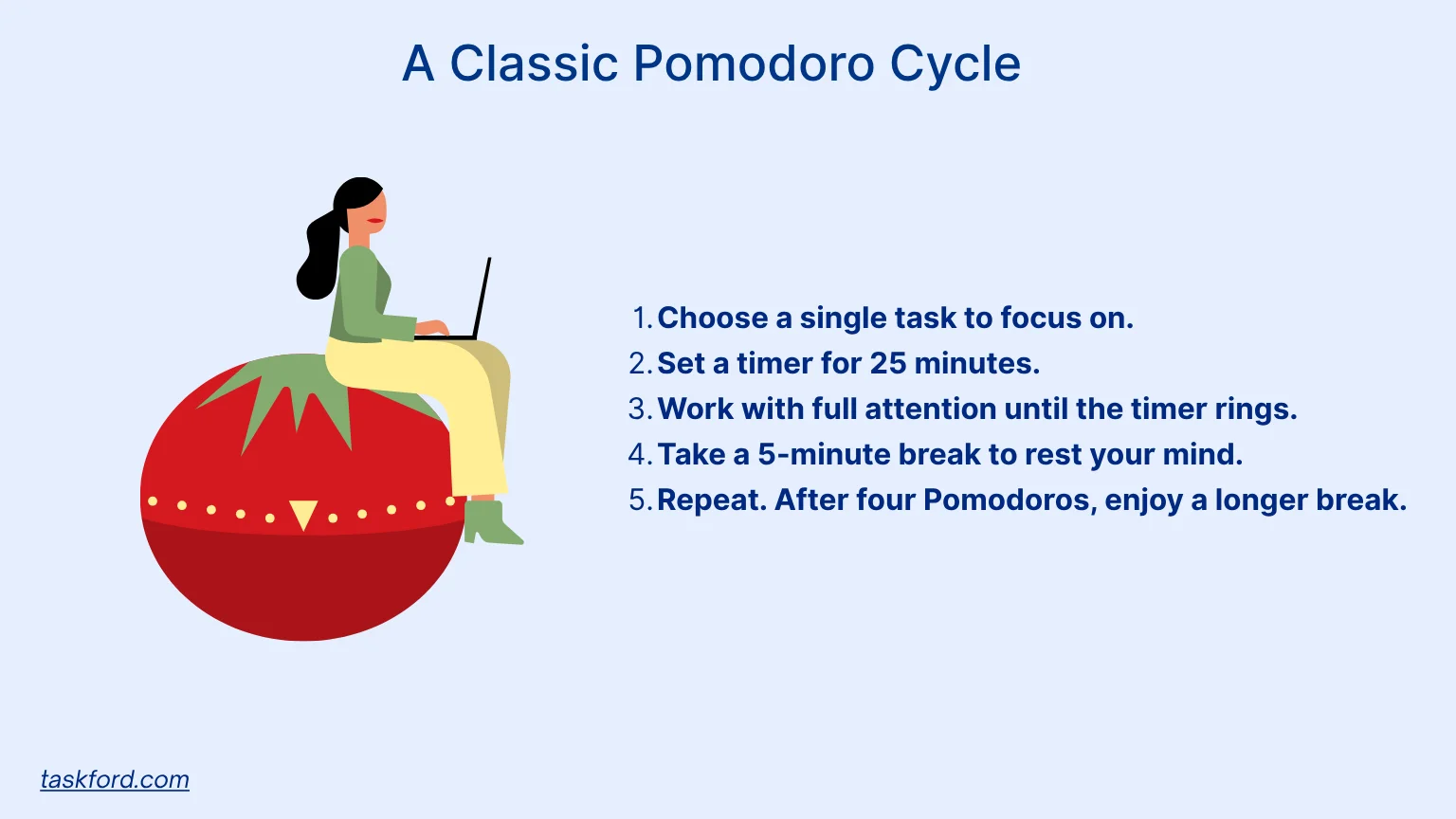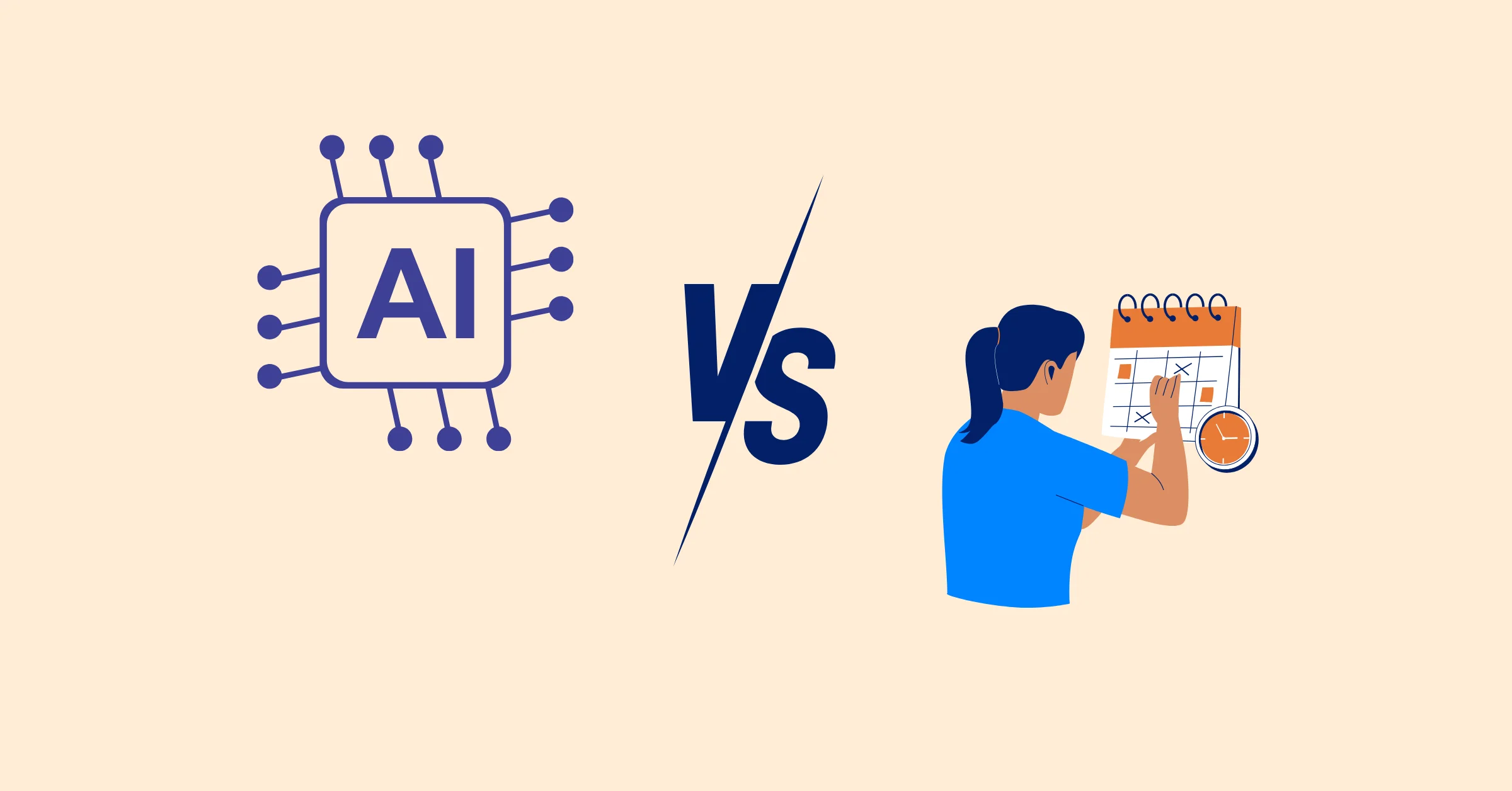Pomodoro Technique: The Habit That Transforms Time Management
Discover how the Pomodoro Technique transforms time management by improving focus, reducing fatigue, and turning productivity into a sustainable habit.
Most professionals try to manage time by scheduling every minute of their day. They use advanced tools, detailed to-do lists, and productivity systems. Yet many still end the day feeling like they’ve fallen short. The real problem isn’t lack of structure, it’s the lack of sustained focus. You can plan every hour perfectly, but if your mind drifts, no schedule can save it.
The Pomodoro Technique offers a different approach. Instead of obsessing over how much time you have, it helps you control how you use it. This method turns time management into a rhythmic practice that balances effort and rest. It builds the muscle of focus, and once you learn to maintain attention, everything else falls into place.
What Is the Pomodoro Technique and Where Did It Come From?

The Pomodoro Technique is a structured time management strategy that divides work into short, focused intervals called Pomodoros. Each Pomodoro typically lasts 25 minutes, followed by a 5-minute break. After four cycles, you take a longer break of 15 to 30 minutes.
This rhythm helps you stay sharp, avoid burnout, and make steady progress especially on large or complex tasks. Instead of facing endless hours of work, you only need to commit to the next 25 minutes.
A quick breakdown of a classic Pomodoro cycle:
- Choose a single task to focus on.
- Set a timer for 25 minutes.
- Work with full attention until the timer rings.
- Take a 5-minute break to rest your mind.
- Repeat. After four Pomodoros, enjoy a longer break.
The technique was created by Francesco Cirillo in the late 1980s. As a university student, Cirillo found himself constantly distracted. To overcome procrastination, he used a simple kitchen timer shaped like a tomato, pomodoro in Italian, and challenged himself to study in short, timed bursts. The results surprised him: short, measured focus sessions helped him accomplish more in less time.
That simple timer evolved into one of the most respected productivity systems in the world. What began as a student’s experiment has become a timeless tool for anyone looking to reclaim focus in an age of distraction.
The Science of Focus: How the Pomodoro Technique Rewires the Brain
The Pomodoro Technique works because it’s designed around how the brain actually processes attention. Our ability to focus isn’t constant, it rises, peaks, and declines within a short time span. Most people experience attention fatigue after about 25 to 40 minutes of uninterrupted work. When that happens, productivity drops, and mental errors increase.
The Pomodoro Technique prevents this decline by introducing micro-recoveries. Each break gives your mind a moment to reset, allowing you to return refreshed and ready for another deep-focus session. This pattern mirrors how elite athletes train: pushing in short bursts, then resting to build endurance.
But the benefits go deeper than energy management.
- The Zeigarnik Effect: Psychologists discovered that people remember unfinished tasks more vividly than completed ones. When a Pomodoro ends mid-task, your brain stays slightly engaged, making it easier to pick up where you left off.
- Dopamine reinforcement: Each completed Pomodoro provides a small hit of dopamine, or the “motivation chemical.” That sense of reward builds momentum and encourages consistency.
- Metacognition: Tracking Pomodoros increases self-awareness. You start to notice your energy cycles, when you lose focus, and how long deep work truly lasts for you.
- Emotional regulation: Time limits reduce anxiety by transforming open-ended tasks into clear, manageable sprints.
In essence, the Pomodoro Technique rewires your brain for mindful productivity. You train attention like a muscle: focus hard, then recover. Over time, this builds a natural rhythm between concentration and rest, turning time management into a deliberate, almost meditative habit.
Customizing the Pomodoro Technique for Advanced Results
The Pomodoro Technique is not a strict rulebook. It’s a flexible framework that adapts to your task type, energy level, and work environment.
Here’s how to tailor it:
| Task Type | Recommended Cycle | Objective |
|---|---|---|
| Deep Work (research, coding, analysis) | 50/10 | Maintain immersion without mental fatigue |
| Creative Work (writing, design, strategy) | 40/10 | Keep creative flow while allowing recovery |
| Routine Tasks (emails, reports, admin) | 20/5 | Stay productive and avoid monotony |
No single rhythm fits everyone. Early risers might prefer longer morning Pomodoros, while others perform best in the late afternoon. What matters is not the duration but the consistency. Test different intervals until you find what sustains both focus and calm.
Once customized, the Pomodoro Technique becomes a personal rhythm rather than a timer rule, one that matches your own mental tempo.
Building a Habit Around the Pomodoro Technique
Consistency transforms the Pomodoro Technique from a method into a lifestyle. The goal isn’t to complete as many Pomodoros as possible, but to build a dependable rhythm of focus and rest every day.
Here are a few strategies to make it a lasting habit:
- Start small. Begin with two Pomodoros a day and build from there. The key is progress, not perfection.
- Habit stacking. Pair your first Pomodoro with something you already do such as starting it right after morning coffee.
- Environmental cues. Use a particular playlist, lighting setup, or desk layout to signal the start of focus time.
- Track progress. Keep a log of completed Pomodoros. Seeing your sessions accumulate creates visible motivation.
Neuroscience supports this repetition. Each time you engage in a focused session, you reinforce neural pathways associated with concentration. Over time, it becomes easier to start, easier to stay focused, and easier to recover when your attention drifts. The Pomodoro Technique isn’t about control, it’s about rhythm, and rhythm thrives on habit.
Using the Pomodoro Technique in Professional Contexts
Professionals across industries use the Pomodoro Technique because it scales with both individual and team work.
- For knowledge workers, it helps manage cognitively heavy tasks like writing, data analysis, or strategic planning. Structured intervals keep the mind sharp and prevent burnout during long projects.
- For project managers, counting Pomodoros can help estimate task effort more accurately than vague time blocks. It creates a clear sense of how much real focus time a project demands.
- For creatives, the rhythm of the technique protects inspiration while preventing mental exhaustion. Short breaks help ideas breathe, while the timer keeps momentum alive.
- For teams, synchronized Pomodoros where everyone focuses and rests together and build a shared sense of flow. It reduces interruptions and fosters mutual respect for focused work time.
No matter the field, the principle remains the same: the Pomodoro Technique turns fragmented attention into intentional focus.
When the Pomodoro Technique Doesn’t Work (and How to Fix It)
The Pomodoro Technique is powerful, but not flawless. Some people find it energizing; others feel restricted or stressed by it. When it doesn’t seem to work, the key is to look at why, and adjust.
Here are some common situations where the technique breaks down, and how to fix them:
- The timer feels stressful: The ticking clock can make focus harder instead of easier. Try using a silent or visual timer instead of one that rings. The goal is gentle structure, not pressure.
- Constant interruptions ruin focus: If calls, chats, or coworkers often break your rhythm, shorter Pomodoros may work better like 15 or 20 minutes instead of 25. You can also block “focus sessions” on your calendar or signal to others that you’re unavailable.
- Tasks are too complex or creative: Some work, like writing, coding, or design, needs longer stretches of flow. Switch to a 40/10 or 50/10 rhythm so you can go deeper before resting.
- You lose momentum when the timer rings: If you’re fully immersed when the bell goes off, keep going. The timer is a guide, not a rule. Take your break only once you feel your focus naturally decline.
- Motivation is low: When starting feels impossible, try a “micro-Pomodoro” of just 5 or 10 minutes. Once you begin, momentum often builds on its own.
- Your workday is too fragmented: If your day involves jumping between emails, meetings, and planning, the technique can feel disjointed. Group similar tasks into back-to-back Pomodoros to stay in the same mental mode longer.
- You don’t see tangible progress: Without visible results, it’s easy to lose interest. Track your Pomodoros. Tools like TaskFord can record your sessions automatically and show how your focus time adds up over the week.
When the Pomodoro Technique doesn’t fit, the problem usually isn’t the system, it’s the rigidity. Think of it as a rhythm to shape your focus, not a rulebook. Adapt it to your work, your energy, and your goals. That’s when the Pomodoro Technique becomes not just a timer, but a personal method for working with clarity and calm.
Digital Tools to Enhance the Pomodoro Technique
Technology can make it easier to apply the Pomodoro Technique consistently, especially when it integrates with your broader work management system. Pomofocus remains a great option for individuals who prefer a lightweight, browser-based timer. It helps you track sessions visually and stay accountable to your focus goals.
For teams or professionals already using TaskFord, its time tracking feature offers a seamless way to apply the Pomodoro Technique directly into daily project work. You can time sessions, record focus hours, and analyze how much productive effort goes into each task. This integration bridges focus and performance data, helping you improve both productivity and planning accuracy.
![]()
Use these tools to measure your rhythm, not your worth. The goal is awareness, or to understand where your focus goes and how to protect it.
Conclusion: Turning the Pomodoro Technique Into a Sustainable Habit
The Pomodoro Technique transforms time management because it respects how the human brain actually works. By breaking effort into cycles of focus and recovery, it helps you maintain clarity and balance instead of chasing endless output. Each interval becomes a deliberate choice to focus on what really matters: one task, one session, one moment at a time.
Its real value lies in sustainability. The Pomodoro Technique doesn’t make you faster; it makes you more present. It helps you finish what you start without draining your mental energy. Try it for one week, observe how your focus changes, and you’ll see that mastering time isn’t about working more hours, it’s about mastering attention within the hours you have.
Learn more
- 10 Practical Time Management Tools & Techniques That Actually Work
- What’s Next for Time Tracking Software? Key Innovation to Watch in 2026
- Manual vs. Automated Time Tracking: Which Method Saves You More Time?
Making work simpler,
smarter, and more connected
Join our waitlist and be notified first.

Subscribe for Expert Tips
Unlock expert insights and stay ahead with TaskFord. Sign up now to receive valuable tips, strategies, and updates directly in your inbox.






